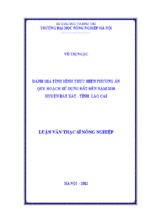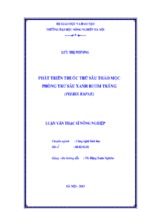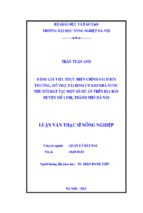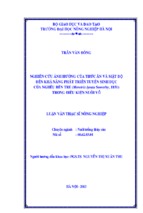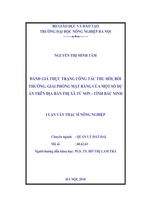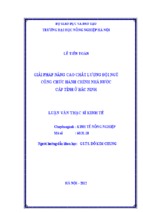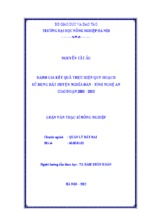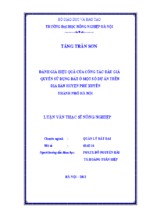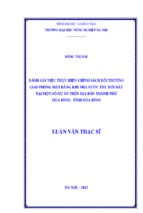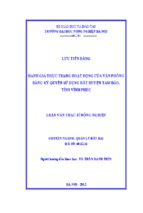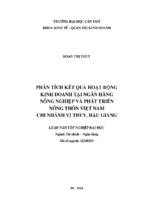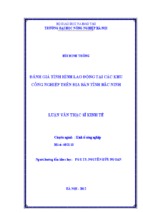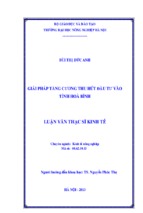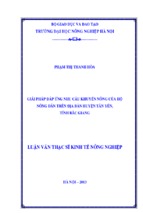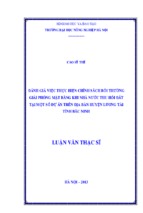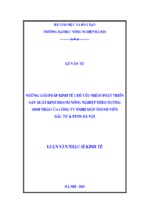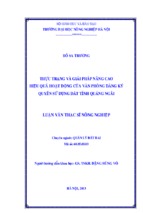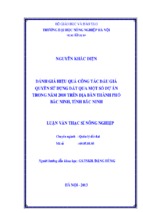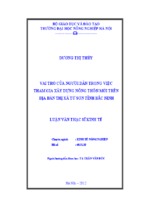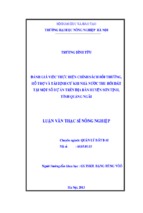THAI NGUYEN UNIVERSITY
SCHOOL OF FOREIGN LANGUAGES
DAO THI HOA
A STUDY OF HIGH SCHOOL STUDENTS' REFUSALS IN ENGLISH
AT CAM PHA HIGH SCHOOL
Nghiên cứu về việc học sinh THPT Cẩm Phả sử dụng tiếng Anh để từ
chối
M.A. THESIS
(APPLICATION ORIENTATION)
Field: English Linguistics
Code: 8220201
Supervisor : Dr. Nguyen Trong Du
THAI NGUYEN – 2019
1
Chapter 1: INTRODUCTION
1.1. Rationale
The idea that brings me to the topic of this study originated from my own
story happening 15 years ago when I was a student at Thai Nguyen University. One
morning, I and one of my classmates went to see our American teacher, Diane.
When we had just been invited to sit down, she asked," Would you like something
to drink?” my friend said: "A cup of tea, please" but I replied: "No, thanks". Then
she brought out just only two cups of tea, one for her and one for my friend. I felt a
bit surprised because normally in our Vietnamese home, we often offer some kinds
of drink to everyone who comes to see us although the guess often says to the host:
Oh, there's no need or you are so careful. Such a situation let me think a lot about
the differences in culture between Vietnamese and Western people. That means the
Vietnamese often do not directly say what they actually mean, but the West prefer a
direct speech act and it is easier to understand.
The given situation raised us a question that to learn a language means we
also have to learn more about another culture. As a non-native teacher of English, I
find myself that it is not enough just to show learners words, structures, and other
language patterns, but we also have to guide them how to use the language into real
life situations effectively and naturally.
It is pragmatics that helps us a lot in dealing with such problems. Pragmatics
is a branch of linguistics dealing with the language in use and the context in which
it is used. And in pragmatics, speech act is an element that a speaker performs when
making an utterance. We perform speech acts when we offer an apology, a greeting,
a request, a complaint, an invitation, a compliment or a refusal. It means speech acts
realize real-life communications.
Therefore, when English teachers are following the communicative approach
in teaching, certain aspects of language use as speech acts need to be taken into
2
account. The refusal speech act used by high school students is a problem which
gains much my attention.
The first concern is the high school students' communicative competence. It
is inevitable to all teachers of English in communicative language teaching (CLT).
The language learners' environment as CLT techniques, the interaction with one
another, authentic texts, in class and outside of class is a consideration. However,
with my experience in teaching high-school students, many of them cannot reply a
request, an offer in the way the English native speakers do, especially in refusing,
they may cause misunderstanding or even face threatening to the hearer.
The next matter is the content of textbook (Tieng Anh 10, 11, 12 )( both 7
years and 10 years). Each unit includes 4 skills and language focus in which the
authors have tried to provide authentic materials for the students to practice.
However, how to adapt these sources to be suitable for students to make use of them
in communication is a concern. Moreover, politeness strategies, which is used to
soften the threat to each other's face is also very important to help a conversation
successful but Vietnamese culture affects politeness strategies, especially the ways
high school students refuse an offer, an invitation, a suggestion because of the
indirect ways of refusing in the way the Vietnamese often do to others.
This study was conducted with the expectation to find out how high school
students refuse to an invitation and a request, whether there is any difference
between what they think they will refuse and the way they really refuse in a given
situation. From the data analysis, I will know more about how Vietnamese cultural
influence on their way of speaking English. After that, some suggestions will be
noted down to help work out the more effective ways of teaching English according
to communicative language teaching approach.
1.2. Aims of the study
The overall of the study aim is to explore how Vietnamese culture affects
refusing strategies in English by Vietnamese high school students. From the
3
investigation, this study will help to find out to what extent Vietnamese high school
students can apply their knowledge into practice, and to suggest some ways for
integrating cultural practices into the high shool curriculum.
1.3. Research questions
Following the aims, the study tries to answer the two questions as
(1)
How do high school students refuse in English?
(2)
Are there any differences between the written and spoken refusals?
1.4. Scope of the study
This study focuses on refusing speech act to the invitations and requests in
English made by high school students. The study is conducted at Cam Pha High
School in Quang Ninh province. 200 students of grade 10 at Cam Pha High School
are involved in the study. The study has been carried out in the second semester of
academic year 2018-2019 with only 10th graders; thus, the respondents does not
represent for all students who study English major in Vietnam. These students are
surveyed to work out how they refuse to the invitations and requests in English and
which Vietnamese cultural practice affects their refusing speech act.
1.5. Significance of the study
The present study partly contributes to provoke both theoretical and practical
utilization of English in communicative situations for the learners. Theoretically, in
spite of certain number of studies previously conducting the investigation into the
refusals in English, they mainly discuss the difference between the ways
Vietnamese respond to a situation and the ones of the Western people. In practice,
the speech acts such as the invitations, the offers or requests and how to respond
them are one of the key points in communicating in daily lifestyles. However, there
has been some gaps between the syllabus for teaching English at high schools and
the ability of using English of students authentically. Thus, this study with a view to
finding out the gap between the English in current textbooks and everyday English
in the aspects of culture will help students get access to practical English.
Furthermore, for the teachers of English, this study is believed to raise the question
of the importance of shifting their teaching approach from teacher-centered to
4
student-centered. This is relevant to the Communicative Language Teaching (CLT)
approach, which has been boosted in the English teaching lessons in education
system of all levels in Vietnam in recent years.
1.6. Design of the study
The study is divided into three main parts: the Introduction, the Development
and the Conclusion with Reference with five chapters
Chapter 1: Introduction - deals with the rationale, aims, scope, methods,
significance and design of the study
Chapter 2: Literature Review- is about to give some theoretical
background related to pragmatics, speech acts, refusing strategies, politeness
strategies, semantic formulas, Communicative Language Teaching (CLT), and
previous studies relating to the topic of the research.
Chapter 3: Methodology- shows the research governing orientation,
research methods and performs the situation analysis, participants, data collection
instruments, data collection procedures and data analysis. The detailed results of the
DCT and role-play and a universal analysis on the collected data are shown.
Chapter 4: Findings and Discussions - presents major findings and
discussions from the data collected in both DCT and role-play.
Chapter 5: Conclusion- concludes a review of the study, limitations of the
study and recommends suggestions for further researches.
5
Chapter 2: LITERATURE REVIEW
It is stated in the previous chapter that the object of this study is the refusals in
English made by the Vietnamese high school students. The refusal is one of the speech
acts in everyday life and speech acts are core issues of pragmatics, a branch of
linguistics. All of these concepts will be described in this chapter.
2.1. Pragmatics and speech act theory
2.1.1. Pragmatics
Pragmatics has been emerged as a branch of modern linguistics because it is
the "science of language as it is used by real, live people, for their own purposes
and within their limitations and affordances" (Mey, 1993, p. 5). Pragmatics is used
to be defined as "the study of language in use" (G. Brown & Yule, 198, p. 27).
Jenny Thomas in Meaning in Interaction: An Introduction to Pragmatics (1995)
mentions pragmatics as "a study of meaning in interaction". The advent of
pragmatics helps to answer the question of why an utterance is semantically correct
but it may cause misunderstanding for the hearers if they do not know in which
context the speaker delivered the utterance.
Pragmatics has played such a preliminary role in teaching and learning
English procedure. Teaching and learning English as EFL has been paid much
attention worldwide because English an international language that connects people
all around the world. However, English is spoken in different settings and levels of
intercommunication among all English speakers who do not share a language or a
culture. As a result, speakers must know many pragmatic elements in order to avoid
inaccuracies and misunderstandings during communication. As a matter of fact,
such a great usage of English language requires a pragmatic competence which will
help all those who speak or learn English as a second language. Thomas defined
pragmatic competence as “… the ability to analyze language in a conscious
manner.” (cited in Holmes & Brown, 2007, p. 524). The meaning includes verbal
6
and non-verbal elements and it varies according to the context, to the relationship
between utterers, also to many other social factors.
Pragmatic competence should be considered as a optimum goal for all those
who teach English as a second language, which constantly represents a challenging
task as well. Pragmatic competence refers to the ability to comprehend, construct
utterances which are accurate and appropriate to the social and cultural
circumstances where the communication occurs. Pragmatics can be simply
understood as a way we convey the meaning through the communication in
practice. For the learners, especially students at school, pragmatics can be seen as
the concrete evidence of students' ability of speaking English to achieve
communication goals.
Pragmatic transfer in refusals is also a remarkable concern. It is likely that
L2 learners may rely on their native language pragmatic knowledge to perform the
target language refusals which may result in pragmatic failures. It occurs when
speakers apply rules from their first language (L1) to their second language (L2).
Beebe et al. (1990), for example, reported evidence of pragmatic transfer in refusals
made by Japanese learners of English. It was found that the content of excuses in
both Japanese and English made by Japanese learners of English was far less
specific than the content of excuses made by American participants.
Language proficiency is also an important factor in pragmatic transfer,
although the analysis has not led to conclusive results. Takahashi and Beebe (1987)
proposed the positive correlation hypothesis, predicting that L2 proficiency is
positively correlated with pragmatic transfer. Despite the fact that Takahashi and
Beebe’s own study on refusals performed by Japanese EFL and ESL learners did
not clearly present the predicted proficiency effect, some studies (e.g. Cohen &
Olshtain, 1981; Blum-Kulka, 1982; Olshtain & Cohen, 1989; Cohen, 1997; Hill,
1997; Keshavarz et al., 2006) have supported Takahashi and Beebe’s notion that
learners’ limited target language knowledge prevents them from transferring native
language pragmatic knowledge. For example, Takahashi and Beebe’s (1987) results
7
showed that highly proficient Japanese ESL learners often used a typically Japanese
formal tone when performing refusals in L2. Also as mentioned by Keshavarz et al.
(2006), more proficient students had enough control over the L2 to express their
first language feelings at the pragmatic level.
2.1.2. Speech acts
In the field of pragmatics, speech acts represent a key concept. It can be
broadly defined as language use in context taking into account the speaker’s and the
addressee’s verbal and non-verbal contributions to the negotiation of meaning in
interaction. It is a unit in which the speakers perform what they want to express by
producing utterances. According to Austin (1962), a single speech act actually
contains three separate but related speech acts: locutionary acts, illocutionary acts,
and perlocutionary acts. According to Susana Nuccetelli and Gary Seay's in
Philosophy of Language: The Central Topics (2007), locutionary acts are "the mere
acts of producing some linguistic sounds or mark with a certain meaning or
reference". Meanwhile, further Austin considers locutionary act as the act of saying
something which has a meaning and creates an understandable utterance to convey
or express. In his point of view, illocutionary act is performed as an act of saying
something or as an act of opposed to saying something. The illocutionary utterance
has a certain force of it. It is well-versed with certain tones, attitudes, feelings, or
emotions. There will be an intention of the speaker or others in illocutionary
utterance. It is often used as a tone of warning in day today life. Therefore, it can be
seen as an offer, an apology, a promise an invitation, a request or a reply to a
question. Perlocutionary act normally creates a sense of consequential effects on the
hearers. The effects may be in the form of thoughts, imaginations, feelings or
emotions. The effect upon the addressee is the main characteristic of perlocutionary
utterances.
Pragmatics is also the performance of speech acts. Austin, together with his
collaborator, Searle, presented their speech act theory basically on single sentences
and only on the speaker' point of view. Therefore, his theory has been shown out
8
many drawbacks with much criticism from other authors. Hatch (1983) argued that
"the same sentences may have the different meanings when said in different
situations. Archer et al., (2012) replaced "speech acts" with "a discourse act" or
"communicative act". Thus, speech acts also take the hearer's perception and
reception into consideration.
2.2. Refusals and the refusing strategies
2.2.1. Refusing definition
As mentioned in the speech acts, the illocutionary utterance as can be seen as
an offer, an apology, a promise, an invitation, a requests or a reply to a question. In
this study, one of the illocutionary utterances will be observed and investigated is
the refusal to an invitation and a request.
Refusing can be understood as the speaker directly or indirectly says no to
his/her interlocutor’s request, invitation or suggestion. Searl (1977) re-classifies
speech acts into five categories and he categorizes refusals into commissives
because they commit the refuser to not performing an action. Meanwhile, Brown
and Levinson (1987) stated that refusals are face-threatening acts and in the same
way as disagreeing and disapproving. Refusing is an act that expresses the refuser's
negative evaluation to the refusee' prior act, threatening the positive face want of a
refusee and showing little care about the refusee's feelings.
Gass & Houck (1999) mentioned refusals as speech acts that occur as
negative responses to other acts such as requests, invitations, offers, and
suggestions. Brown and Levinson (1987), Fraser (1990), Smith (1998) also agree
that refusals are sensitive to social variables such as gender, age, level of education,
power and social distance. Hence, refusals are significant to explore the various
cultural aspects of language from the sociolinguistic perspective. Brasdefer (2006)
claims that refusals are complex speech acts that require not only long sequences of
negotiation and cooperative achievements, but also ‘‘face - saving maneuvers to
accommodate the noncompliant nature of the act.” (Gas and Houck, 1999, P.2). In
general, refusing is a speech act consisting of both social and linguistic patterns.
9
2.2.2. Refusing strategies
Refusing is complex issue and this speech act has attracted researchers’
attention as mentioned. Among the existing studies, the most influential and bestknown study on refusals is namely Beebe, Takahashi and Uliss-Weltz’s (1990)
taxonomy. In their study, they use DCT as a tool to examine how Japanese learners
of English refused requests, invitations, offers and suggestions. Their
classification is divided into semantic formulas, which are the expressions used to
perform a refusal and adjuncts, that is, expressions which occur with a refusal but
themselves not be used to perform a refusal. The two components - semantic
formulas and adjuncts- are described as follow:
Classification of Refusals
I. Direct
A. Performative (e.g., “I refuse”)
B. Non performative statement
1. “No’
2. Negative willingness/ability (“I can’t.” “I won’t.”..)
II. Indirect
A.
B.
C.
D.
E.
F.
G.
H.
I.
Statement of regret (e.g., “I’m sorry…”)
Wish (e.g., “I wish I could help you…”)
Excuse, reason, explanation (e.g., “I am busy with my homework")
Statement of alternative
1. I can do X instead of Y (e.g., “I’d rather…”)
2. Why don’t you do X instead of Y
(e.g., “Why don’t you ask someone else?”)
Set condition for future or past acceptance
(e.g., “If I am invited next time…”)
Promise of future acceptance
(e.g., “I promise I’ll…” or “Next time I’ll …” – using “will” of promise
or “promise”)
Statement of principle (e.g., “ I never do business with friends.”)
Statement of philosophy (e.g., “One can’t be too careful.”)
Attempt to dissuade interlocutor
1. Threat of statement of negative consequences to the requester (e.g., “I
won’t be any fun tonight” to refuse an invitation)
10
2. Guilt trip (e.g., waitress to customers who want to sit a while: “I can’t
make a living off people who just order coffee.”)
3. Criticize the request/requester, etc. (statement of negative feeling or
opinion); insult/attack (e.g., “Who do you think you are?”)
4. Request for help, empathy, and assistance by dropping or holding the
request.
5. Let interlocutor off the hook (e.g., "Okay." “Don’t worry about it.”)
6. Self-defense (e.g., “I’m trying my best.” )
J. Acceptance that functions as a refusal
1. Unspecific or indefinite reply
2. Lack of enthusiasm
K. Avoidance
1. Nonverbal
a. Silence
b. Hesitation
c. Do nothing
d. Physical departure
2. Verbal
a. Topic switch
b. Joke
c. Repetition of part of request, etc. (e.g., “Monday?”)
d. Postponement (e.g., “I’ll think about it.”)
e. Hedging (e.g. “I’m not sure.”)
Adjuncts to refusals
1. Statement of positive opinion/feeling or agreement (“That sounds good …”;
“I’d love to…”)
2. Statement of empathy (e.g., “I realize you are in a difficult situation”)
3. Pause fillers (e.g., “er”; “well”; “oh”; “uhm”)
4. Gratitude/appreciation
Following the classification, the refusers may employ some refusing
strategies to respond to certain speech acts. They can say "No" to refuse a request,
an offer or an invitation in a direct way.
However, due to the face-threatening nature the refusal involves, which
means it threatens the addressee’s negative face, refusing usually includes various
strategies which aim to avoid offending the other interlocutor. Indirectness
strategies are frequently used to avoid face- threatening of a refusal. According to
11
Al- Eryani (2007), “refusal is a face-threatening act to the listener/ requester/
inviter, because it contradicts his or her expectations, and is often realised through
indirect strategies”(p.21). Indirectness is a highly-used strategy in Vietnamese
refusing. It can be seen from the studies of the Vietnamese writers such as M. T. P.
Nguyễn (2006), T. V. Q. Phan (2001), and C. M. Trần (2005c). All of them agree
that indirectness is a preferred refusing strategy to avoid confrontation and conduct
defense. Beebe et al, (1990) shows that the indirectness of refusing results in the
fact that the message of a refusal is often hidden in another speech act such as a
blame, a complaint, a topic switch, a joke or a statement of principle.
Refusing in fact is a complex issue. However, this speech act has been a
concern to many writers who carried out various studies on this aspect. They are
Kitao (1996), Felix-Brasdefer (2003), Al-Kahtani 2005, Tran, C. M. (2005c),
Bardovi-Harlig et al-2008, Campillo (2009), Ebsworth, M.E & Kodama-2011. (See
References). In these studies, the writers have shown many differences in refusing
among English learners from different cultures. Vietnamese culture is not an
exception. Vietnamese refusing speech act is a topic that has been conducted in
many studies such as Phương thức biểu hiện hành vi từ chối lời cầu khiến trong
tiếng Anh (liên hệ với tiếng Việt) by Tran Chi Mai (2005c), (2005d), Cross-cultural
pragmatics: Refusals of requests by Australian native speakers of English and
Vietnamese learners of English by Nguyen Thi Minh Phuong (2006), and The
culture of Vietnamese refusing: A mixed-methods multi-perspectival approach by
Nguyen Trong Du (2016).
2.2.3. The notion of face in politeness and refusing strategies
It is obviously realized from the findings of the previous studies on refusals
in English that indirect strategies is preferred due to the face- savings or facethreatening avoidance.
“Face” is “something that is emotionally invested, and that can be lost,
maintained, or enhanced and must be constantly attended to interaction.” (Brown
and Levinson,1987, p.66). According to Brown and Levinson (1987), an individual's
12
face needs motivate us to apply politeness strategies. Face here refers to the
individual's self-esteem, and these authors mention that both positive face and
negative face are wished to be maintained by all individuals. Goffman (1967) gives
the definition of "face work" - the way in which people maintain their face. He also
describes politeness in as "the appreciation an individual shows to another through
avoidance or presentation of rituals".( Interaction Rituals: Essays in Face-to-face
Behaviour, p.77). Meanwhile Leech (1983) considers politeness as forms of
behavior aim at creating and maintaining harmonious interaction. Based on Brown
and Levinson's (1987) framework of politeness, three kinds of politeness systems:
1) difference, 2) solidarity, and 3) hierarchical and two contextual variables, a)
power and b) distance between participants, are involved in determining the
politeness system are proposed by Scollon, Scollon and Jones (2012). In
Vietnamese culture, the framework can be seen obviously through the way people
greet and address the others in daily conversations.
One factor that closely relates to politeness is face-threatening act (FTA).
Nguyen Thi Mai Phuong (2006) recommends in her dissertation that in daily
communication, people may pose a threat to another individual’s self-image, or
create a “face-threatening act” (FTA). These acts impede the freedom of actions
(negative face), and the wish that one’s wants be desired by others (positive face)
– by either the speaker, or the addressee, or both. Requests potentially threaten the
addressee’s face because they may restrict the addressee’s freedom to act
according to his/her will (Holtgraves 2002, p.40). Refusals, on the other hand,
may threaten the addressee’s positive face because they may imply that what
he/she says is not favored by the speaker. In an attempt to avoid FTAs,
interlocutors use specific strategies to minimize the threat according to a rational
assessment of the face risk to participant.
2.2.4. Refusing in relation to Vietnamese politeness strategies
Assessment of the face risk to the other interlocutor is also a typical feature
of Vietnamese culture, which results from the influence of Confucianism ideology
13
remnants. It decides whether the addresser use the politeness strategies or not in
refusing a request, an invitation or an offer and so on.
According to Nguyen Trong Du (2016), to understand how people use
language, for example what strategies they use in refusing and why they rely on
such strategies, one must get to know about their cultural backgrounds. The refuser
may commit the face-threatening act when the refusee is at a higher social status,
more powerful and he/she appreciate the closer distance. This is also a cultural
factor discussed by Hofstede, Hofstede, & Minkov (2010). They argue that
superiors are people who have the privilege to make their own rules and to initiate
contact with subordinates. Employees are thus expected to do as they are told and
therefore expect their ideal boss to be a “benevolent autocrat or a ‘good father'" (p.
73).
Brown and Levinson (1987) are probably considered the most influential
authors in politeness theory. They produce the following figure shows strategies
that are chosen when a speaker does an FTA to a listener. Face threatening acts
(FTAs) can be done:
+ on the record - unambiguously and with a certain directness, it show exactly what
the actor has in mind
+ off the record - ambiguously and with a certain indirectness, the actor cannot be
held to a particular intent
+ baldly, without redress - clearly, unambiguously and in the most direct manner
(e.g. Do X! / Don't do Y)
+ with redress – to give face and counteract potential face damage
Figure 1: Brown and Levinsons (1987) - Strategies for doing an FTA
14
Their figure showing the strategies for doing FTA consists of two types of
politeness strategies: positive strategies and negative strategies.
Following the figure, positive politeness strategies are those which show the
closeness, intimacy, and rapport between speaker and hearer and negative
politeness strategies are those which indicate the social distance between speaker
and hearer. Here it is one of the linguistic functions that express the social distance
between speakers and their different role relationships. It is the face-work which is
an attempt to establish, maintain, and save face during conversations carried out in
a speech community.
Different languages are distinguishable from each other in employing which
politeness strategies in conducting speech acts. Refusing is not an exception.
Deference is heavily paid much attention to in Vietnamese refusals because of
deeply- seated beliefs by Confucian philosophies. Take Japan for example. Japan is
also an Asian country like Vietnam. In a study, a Japanese writer, Ueda (1972),
listed 16 ways to avoid saying "No" in Japanese
(Vague no, silence, delaying
answers, among others). Some years later, Rubin (1983) claimed that there were
the following 9 ways of refusing across a number of cultures:
In an early attempt to classify the realization of refusals,
1. Be silent, hesitate, show a lack of enthusiasm
15
2. Offer an alternative
3. Postponement
4. Blame on a third party or something over which you are out of control
5. Avoidance
6. General acceptance of an offer or an invitation but giving no details
7. Divert and distract the addressee
8. General acceptance with excuses
9. Say what is offered is inappropriate
It is universally agreed among many studies on refusals that Vietnamese
people choose the same strategies in refusing to an invitation or a request without
having to say "No" in a direct way.
2.3. The previous studies on refusals
2.3.1. Cross-cultural refusal studies
Kwon (2004) agrees that refusing can be a difficult speech act to perform
appropriately both linguistically and psychologically because the possibility of
offending the interlocutor is inherent in the act itself and a failure to refuse
appropriately can risk the interpersonal relationship. Nguyen Trong Du (2016)
claims that refusing usually includes various strategies which are aimed at avoiding
offending the other interlocutor. Therefore, the previous cross-cultural refusal
studies are dealing with the refusals under the aspect of cultural influence. Zohreh
Rasekh Eslami (2010) has a conclusion that the cross-cultural studies on refusals
show that different cultures perform refusals differently. Their degree of directness in
refusals, their sensitivity to social variables, and their performance in terms of the
content of strategies might vary.
Many authors agreed on the face-threatening nature of refusals. T AlEryani (2007, p. 21) d e f i n e d refusal as a face-threatening act to the listener/
requester/inviter, because it contradicts his or her expectations, and is often
realized through indirect strategies. H. J. Chen (1996) also claimed a direct
refusal as a simple negative is not a common strategy for communicators,
16
regardless of their language background. Thus, it is undeniable that the face threatening nature results in the use of indirectness of refusing strategies. From
the Beebe, Takahashi, and Uliss-Weltz’s (1990) taxonomy, it can be seen the
fact that the indirectness of refusing the message of a refusal is often hidden in
another speech act such as a blame, a complaint, a topic switch, a joke, a
statement of principle so on and so forth (see Beebe et al, 1990).
In addition, some Vietnamese writers, such as T. M. P. Nguyen (2006),
T.V. Q. Phan (2001), and C. M. Trần (2005c) all reached the conclusion that
indirectness is a highly-used strategy in Vietnamese refusing. Most participants
employed indirect refusals to respond to a request, an invitation or a suggestion to
avoid confrontation and offence.
The differences in cultural practices among the countries are the key
linguistic resources in cross-cultural studies. In the dissertation of Nguyen Trong
Du (2016), he shows the two points of views of Thomas (1983) dealing with
pragmatics. She argued that when dealing with students’ pragmatic failures in
cross-cultural communication, pragma-linguistic failure can be easier to fix than
socio-pragmatic
failure.
She
claimed
this
is
because
the
linguistic
conventionalized forms “can be taught quite straightforwardly as ‘part of the
grammar’ whereas socio-pragmatic failure relates to the student’s cultural beliefs
as much as his/her knowledge of the language.
In general, the cross-cultural studies on refusals gain a conclusion that
despite the sharing of similar strategies in refusing among different cultures, the
choice of directness, mitigation and the explanation or reasons for a refusal may
vary across the cultures.
2.3.2. Interventional studies on refusals
While there are a number of studies which investigate refusal speech act
from cross-cultural perspectives, the number of interventional studies on the effects
of instruction on learners' acquisition of polite refusal strategies is restricted. The
writers such as King & Silver, 1993; Morrow, 1996; Kondo, 2001, 2008; Bacelar
17
Da Silva, 2003 conducted their interventional studies and have made significant
contribution to apply pragmatics in teaching and learning English process.
In King and Silver's study (1993), a pre-test/post-test treatment with a
control group design is used, and taught polite refusal strategies to six intermediate
level learners of ESL. Discussions of personal experience, reading and analysis of
dialogues, explicit teaching, and role-plays were implemented during a seventyminute class. However, the learners had not many opportunities for out- put practice
because of time constraints. A discourse completion questionnaire as a pre-test and
post-test and telephone talks as a delayed post-test were used as research tools. The
results showed limited effect of instruction on the written post-test and no effect on
the delayed post-test. The authors reveal that the lack of exposure to natural data as
input and limited output practice opportunities could have caused the minimum
effect of instruction.
Morrow (1996) studied the effect of instruction on learners’ production of
refusals and complaint speech acts. His study followed a pre-test/post-test design,
without a control group. He adopted an explicit approach which included
explanation of semantic formulas, controlled output practice, and role plays for
teaching the intended speech acts. The results of the study showed that learners
improved both in clarity and politeness. However, the delayed post-test results (6
months after) did not display a significant treatment effect. The weakness of the
study is that the non-significant delayed post-test results could be attributed to the
small number of participants who came for the post-test.
Kondo (2001), a Japanese writer, conducted another interventional study on
refusals involving thirty-five Japanese learners of English. Her study on refusals is
the most recent study in this area. She examined the instructional effects after
teaching the learners with methods and materials that were specifically developed
for teaching pragmatics to Japanese. Similar to Morrow’s (1996) study, this study
used a pre-test/post-test design without a control group. A DCT was used for both
pre-test and post-test data. The results showed the effectiveness of instructional
treatment and a change in learners’ refusals approximating target language
18
(American English) refusals. The instructional procedure raised awareness
concerning various pragmatic aspects involved in the speech act of refusals reflects
the content of the class discussions.
Overall, the interventional studies on English refusals reveal the
effectiveness of instruction on pragmatic development of learners. On the other
hands, the aspect of linguistic applications has been a concern to researchers,
educationists and teachers. They have been trying to work out the link between the
pragmatics and English communication approach. Both cross-cultural studies and
interventional studies on English refusals employ Beebe et al.’s (1990)
classification of refusal strategies to cover refusal strategies in response to
invitations, requests, suggestions, and offers. Their classification system of
strategies is therefore all-inclusive, and can be used for teaching refusals that are the
second pair part of any of these speech acts.
Therefore, in the current study, in order to maintain focus and be practical,
only refusals to invitations and requests are examined. The refusees are only
Vietnamese high school students, thus no comparison between the native English
speakers and non-native counterparts was made. In terms of cultural aspects, this
study is about to show any factors that may affect interlocutors when refusing in
English.
19
CHAPTER 3: METHODOLODY
This study was conducted in order to examine that how Vietnamese culture
affects high school students in choosing the refusing strategies when they are
engaged in the daily conversations in English. To achieve the purposes, this study
employed both quantitative and qualitative methods - mixed methods approach.
3.1. Study method
This study investigates how Vietnamese high school students refuse in English
and explore whether there is any difference between the written and spoken refusals;
hence, there was a need to examine high school students in both categories of using
English: writing and speaking refusals in English. To check the students' written
refusals, the written DCT in form of a survey questionnaire was delivered to collect
data in a short period of time over 200 students of grade 10 at Cam Pha High School.
Additionally, role-play was used to gather data in the form of spoken refusals made by
the participants who had attended the DCT. The point from using these instruments is
to form a complete understanding about the study and make the findings more valid
and objective through a mixed method research.
Mixed methods research has increased in popularity in recent years.
According to Cresswell (2014, 4th ed.) in Research Design: Qualitative,
Quantitative and Mixed method Approaches, mixed method is “an approach to
inquiry that combines both qualitative and quantitative forms of research. It
involves philosophical assumptions, the use of qualitative and quantitative
approaches, and the mixing or integrating of both approaches in a study.” Mixed
method research has been defined as “the class of research where the researcher
mixes or combines quantitative and qualitative research techniques, methods,
approaches…in a single study” (Johnson and Onwuegbuzie, 2004, p.17). Manfred
Max Bergman (2012) in The Good, the Bad, and the Ugly in Mixed Methods
Research and Design concluded that “Despite these weaknesses, challenges, or
unresolved problems, MMRD (mix method research design) often offers
considerable advantages compared to mono- method research. It can cross-validate
20
- Xem thêm -

